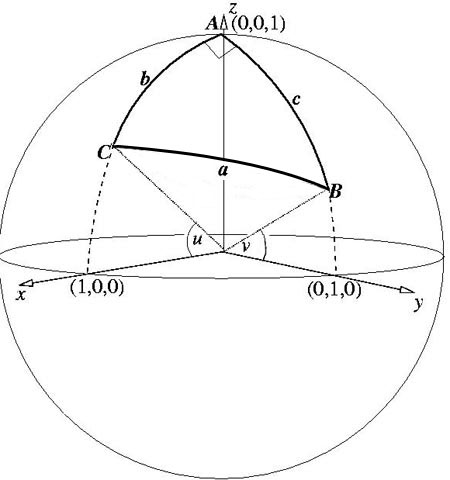Skip over navigation



Or search by topic
Number and algebra
Geometry and measure
Probability and statistics
Working mathematically
Advanced mathematics
For younger learners
Pythagoras on a Sphere
Age 16 to 18
Challenge Level 





- Problem
- Getting Started
- Student Solutions
- Teachers' Resources
|
All angles are in radians.
(1) Without loss of generality take coordinate axes so that
$A$ is the point$(0,0,1)$, the xz-plane contains the point $C$ and
the yz-plane contains the point $B$.
(2) Thinking of $A$ as the North Pole then $C$ has latitude
$u$ and longitude 0 and $B$ has latitude $v$ and longitude
$\pi/2$.
(3) Find the 3D coordinates of $B$ and $C$. Where the origin O
is the centre of the sphere ${\bf OA, OB}$ and ${\bf OC}$ are
vectors of unit length.
(4) Use scalar products and vectors ${\bf OA, OB}$ and ${\bf
OC}$ to find the lengths of the arcs $AB, BC$ and $CA$ in terms of
$u$ and $v$. The required result follows.
|
 |
You may also like
Flexi Quads
A quadrilateral changes shape with the edge lengths constant. Show the scalar product of the diagonals is constant. If the diagonals are perpendicular in one position are they always perpendicular?
Flexi Quad Tan
As a quadrilateral Q is deformed (keeping the edge lengths constnt) the diagonals and the angle X between them change. Prove that the area of Q is proportional to tanX.
Air Routes
Find the distance of the shortest air route at an altitude of 6000 metres between London and Cape Town given the latitudes and longitudes. A simple application of scalar products of vectors.

